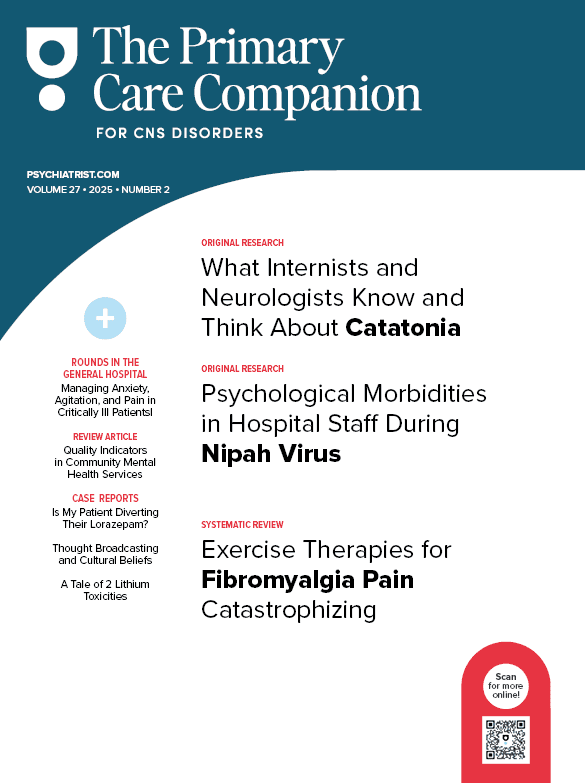Behavioral Management of Tourette’s Disorder in a 5-Year-Old Child
To the Editor: Tourette’s disorder is a chronic condition frequently causing functional and psychosocial impairment in young children. Typically, both vocal and motor tics begin at school age. Tic severity peaks around adolescence, often declining by adulthood.1 According to the Centers for Disease Control and Prevention (CDC), about 27% of children report moderate to severe symptoms.2 This finding would suggest that the majority of children with Tourette’s disorder have a milder symptomatic presentation.
Despite psychopharmacologic advances, high-potency antipsychotics remain the mainstay of treatment. Even though these medications are effective in symptom reduction, they are rarely successful in eliminating tics altogether.1 Further, the side effects of medications such as haloperidol, risperidone, and pimozide may outweigh the benefits in young children with mild to moderate symptomatic presentation. Comprehensive Behavior Intervention for Tics (CBIT), a manualized behavioral treatment based on habit reversal training, offers a safer and effective psychotherapeutic alternative.1,3 However, its application is thus far limited due to the limited number of trained providers and challenges with insurance coverage.3 Further, in younger children who may not be able to comprehend premonitory sensations, the utilization of tic awareness—an important feature of CBIT—may not be possible. Though CBIT emphasizes the importance of tic awareness in habit reversal training, some have suggested that tic awareness may not be an essential element in reduction of tic severity.4,5
I describe a case of Tourette’s disorder in a 5-year-old child who benefited from the components of CBIT even though my colleagues and I were unable to establish awareness of premonitory signs associated with vocal and motor tics.
Case report. A 5-year-old boy presented with complaints of worsening "tics." According to his parents, symptoms consisted of frequent throat clearing, grunting, grimacing, and jaw stretching. His neurologist, who made the initial diagnosis of Tourette’s disorder, referred him for outpatient behavioral treatment. After detailed evaluation, a tic hierarchy was completed, and it was determined that frequent vocalizations were the most impairing tics. Both in school and at home, these tics frequently invited negative attention from peers, sibling, and parents. Caregivers often reprimanded him for making "embarrassing sounds," whereas peers made fun by copying him.
Over several sessions, psychoeducation was provided to parents and grandparents. The schoolteacher was also included by having parents share information and occasional phone consultations. Several themes emerged during these conversations: parents had difficulty believing that tics were involuntary since, in several instances, the patient was able to control them; similarly, grandparents viewed tics as "controlling" behaviors. Caregivers responded to psychoeducation and started conceptualizing tics as a neurologic manifestation. They also responded to parent management training emphasizing appropriate and consistent disciplining methods. Competing responses were discussed, demonstrated, and practiced during sessions and at home. At school, the child started sitting in the front of the classroom, thereby reducing negative attention by peers. When vocalizations emerged, his teacher directed him to a cup of water by a gentle touch on his shoulder without making it obvious to other students; the ingesting movement’s incompatibility with throat clearing and grunting acted as a vocal tic suppression strategy. The child responded to treatment, and the severity of his tics was reduced significantly, leading to increased participation in school activities and at home. My colleagues and I did not notice tic substitution or worsening.
Tics may be debilitating for younger children and are generally worsened by environmental stressors. CBIT offers a safe and effective treatment option in children for tics with varying severity. In specific instances when a complete manualized approach might not be possible, individual strategies such as functional analysis and habit reversal may still be useful in reducing tic severity. In addition to this being a single case-based finding, one should also take into account that no objective measure of tic severity was utilized in assessing baseline or post treatment symptomatology. Nevertheless, clinical improvement was correlated with caregiver and teacher report of symptom reduction.
References
1. Piacentini J, Woods DW, Scahill L, et al. Behavior therapy for children with Tourette disorder: a randomized controlled trial. JAMA. 2010;303(19):1929-1937. PubMed doi:10.1001/jama.2010.607
2. Centers for Disease Control and Prevention (CDC). Prevalence of diagnosed Tourette syndrome in persons aged 6-17 years—United States, 2007. MMWR Morb Mortal Wkly Rep. 2009;58(21):581-585. PubMed
3. Scahill L, Woods DW, Himle MB, et al. Current controversies on the role of behavior therapy in Tourette syndrome. Mov Disord. 2013;28(9):1179-1183. PubMed doi:10.1002/mds.25488
4. Ganos C, Kahl U, Schunke O, et al. Are premonitory urges a prerequisite of tic inhibition in Gilles de la Tourette syndrome? J Neurol Neurosurg Psychiatry. 2012;83(10):975-978. PubMed doi:10.1136/jnnp-2012-303033
5. Banaschewski T, Woerner W, Rothenberger A. Premonitory sensory phenomena and suppressibility of tics in Tourette syndrome: developmental aspects in children and adolescents. Dev Med Child Neurol. 2003;45(10):700-703. PubMed doi:10.1111/j.1469-8749.2003.tb00873.x
Author affiliation: Henry Ford Behavioral Health Services, Henry Ford Health System, Detroit, Michigan.
Potential conflicts of interest: None reported.
Funding/support: None reported.
Published online: February 6, 2014.
Prim Care Companion CNS Disord 2014;16(1):doi:10.4088/PCC.13l01561
© Copyright 2014 Physicians Postgraduate Press, Inc.

